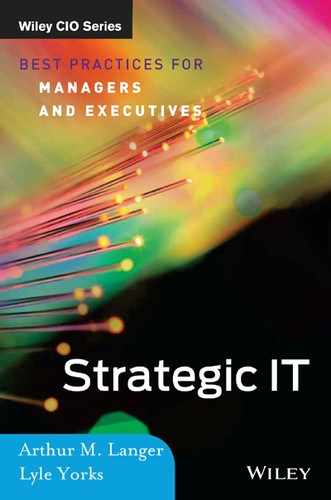Chapter 6
Lessons Learned and Best Practices
The previous chapters provided many lessons learned about how chief information officers (CIOs) are successful. As a result, we lay the foundation for the formation of “best practices” to formalize the necessary attributes for rising to the CIO level and, more important, sustaining a leadership role. First, it is important to define what we mean by best practices and specify what components comprise that definition. Best practices are defined as generally accepted ways of doing specific functions and/or processes by a particular profession or industry. Best practices, in the context of the CIO, are a set of processes, behaviors, and organizational structures that tend to provide successful foundations to implement and sustain success. We stated earlier that CIOs needed to help create organizations that use responsive organizational dynamism (ROD) to successfully deal with the volatility of advancing technologies—technologies that challenge the organization to manage a constant state of dynamic and unpredictable change. We also discussed the need for CIOs to integrate with their C-suite colleagues by using strategic advocacy concepts and build the kind of executive collaborations that would allow them to successfully implement ROD. The case studies in Chapter 4 showed that these two issues were consistently the key reasons for the successful accomplishments of the selected CIOs.
Five Pillars to CIO Success—Lessons Learned
In 2011, 30 new graduate students at Columbia University started their development toward becoming tomorrow's CIOs. During the four-day inaugural course, we had a number of notable CIOs, board members, and chief executives from such companies as BP, JetBlue, Russell Reynolds, ICAP, Sealed Air, and Atlas, to name a few.
As we listened to each presentation, it became clear to me how consistent the messages were from these successful leaders with the results of our case studies in this book. The following are those five key issues discussed and why they are so important for CIO success and ultimately represent the lessons learned summarized best in Chapter 5:
Thus, at Columbia University, the message was loud and clear. CIOs need to communicate to better integrate with the business, be patient and persevere over their failures, and never forget to be a good fiscal partner! The question then is: what are the set of things that need to happen to create a template for success?
Perhaps most important is that best practices can be obtained only by creating a learning organizations that can support the CIO, that is, it is not just the perfect CIO that makes organizations successful, but rather the CIO's ability to establish the necessary supporting cast of senior and middle managers. Therefore, Langer developed these best practices with the perspective that they must operate across the three key levels of any organization: the CIO, the CEO, and middle-management personnel.1 However, these multiple tiers of best practices need to be integrated and to operate with one another in order to be considered under the rubric. Indeed, best practices contained solely within a discipline or community is limited in their ability to operate on an organization-wide level. It is the objective of this chapter, therefore, to formulate a set of distinctive yet integrated best practices that that can establish and support ROD by creating a balanced management structure. Each component of the set of best practice needs to be accompanied with a maturity arc, which defines and describes the stages of development and the dimensions that comprise best practices. Each stage will define a linear path of continued progress until a set of best practices is reached. In this way, organizations can assess where they are in terms of best practices, and determine what they need to do to progress.
Ultimately, each maturity arc will represent a subset of the overall set of best practices for the organization. This concept is important in that it suggests that the CIO alone cannot create a sustainable technology-ready organization. Does this mean that the successful CIOs we examined were only successful because they had the right support from their CEO and middle-management teams? Not exactly, but our philosophy does advocate the need to have the right CEO in place, or the ability as emphasized earlier to influence the CEO to understand what he or she needs to do to maximize the ability for the CIO to succeed. By middle management we mean what Langer defined as “line managers.”2 Line managers were defined as individuals who “usually manage an entire business unit and have return-on-investment responsibilities.”3 In other words, line managers run the day-to-day business. In some ways, the CEO and CIO can influence line management behavior and culture, however, in other ways they cannot without revolutionary patterns of change—typically meaning forced elimination of managers. Indeed, Langer's case study, “Ravell” concluded “the success of organizational learning will depend on the degree of cross fertilization…and the ability of the community to combine new concepts and beliefs to form a hybrid culture.”4
The CIO or Chief IT Executive
Langer used the title “chief IT executive” to represent the most senior IT individual in an organization.5 While these titles are distinct among themselves, he found that they are not consistently followed in organizations. However, it is important to understand these titles and their distinctions, particularly because an organizational learning practitioner will encounter them in practice. These titles and roles are listed and discussed next:
- Chief information officer (CIO). This individual is usually the most senior IT executive in an organization, although not every organization has such a person. The CIO is not necessarily the most technical of people or even someone who has come through the “ranks” of IT. Instead, this individual is considered an executive who understands how technology needs to be integrated within the organization. CIOs typically have other top IT executives and managers who can report directly to them. As shown in the Siemens case study, there can be a number of alternate levels of CIOs, from corporate CIOs to local CIOs of a company division. For the purposes of this discussion, I take up the corporate CIO, who is considered part of the senior executive management team. My research on CEO perceptions of technology and business strategy shows that only a small percentage of CIOs report directly to the CEO of their organization, so it would be incorrect to generalize that they report to the most senior executive. In many cases, the CIO reports to the chief operating officer, or the COO. As stated earlier, the role of the CIO is to manage information with business needs and strategy. Technology, then, is considered a valuable part of knowledge management from the strategic perspective as opposed to just a technical one.
- Chief technology officer (CTO). This individual, unlike the CIO, is very much a senior technical person. The role of the CTO is to ensure that the organization is using the best and most cost-effective technology to achieve its goals. One could argue that the CTO is more of a research and development type of position. In many organizations, the CTO reports directly to the CIO and is seen as a component of the overall IT infrastructure. However, some companies like Ravell and HTC only have a CTO, and view technology more from the technical perspective.
- Chief knowledge officer (CKO). This role derives from library management organizations because of the relevance of the word knowledge. It also competes somewhat with CIO when organizations view technology more from a knowledge perspective. In larger organizations, the CKO may report directly to the CIO. In its purist role, the CKO is responsible for developing an overall infrastructure for managing knowledge, including intellectual capital, sharing of information, and worker communication. Based on this description, the CKO is not necessarily associated with technology, but is more often considered part of the technology infrastructure due to the relevance of knowledge to technology.
In order to define best practices for this function, it is necessary to understand the current information and statistics about what these people do, and how they do it. Most of the statistical data about the roles and responsibilities of chief IT executives is reported under the auspices of the CIO.
From a best practices perspective, the following list from our case studies suggests what chief IT executives should be doing. The list emphasizes team building, coaching, motivating, and mentoring as techniques for implementing these best practices.
- Strategic thinking. Understanding the company's business strategy and competitive landscape to apply technology in the most valuable way to the organization.
- Industry expertise. Must have the ability to understand the product and services that the company produces.
- Create and manage change. Ability to create change, through technology, in the organization's operating and business processes in order to gain efficiency and competitive advantage.
- Communications. Ability to communicate ideas, to give direction, listen, negotiate, persuade, and resolve conflicts. Must be able translate technical information to those who are not technologically literate or are outside IT. Chief IT executives also need to be comfortable speaking in public forums and in front of other executives.
- Relationships building. Ability to interface with peers, superiors, and customers by establishing and maintaining strong rapport, bond, and trust between individuals.
- Business knowledge. Ability to develop strong business acumen and have peripheral vision across all functional areas of the business.
- Technology proficiency. Knowledge to identify appropriate technologies that are the most pragmatic for the business and can be delivered quickly, at the lowest cost, produce an impact to the bottom line (ROI), and have longevity.
- Leadership. Must be a visionary person, inspirational, influential, creative, fair, and open-minded with individuals within and outside the organization.
- Management skills. Ability to direct and supervise people, projects, resources, budget, and vendors.
- Hiring and retention. Ability to recognize, cultivate, and retain IT talent.
While the previous list is not an exhaustive, it provides a general perspective, and one that appears very generic; that is, many management positions in an organization might contain similar requirements. A survey of 500 CIOs (performed by CIO magazine) rated the top three most important concerns among this community in terms of importance:
What is very interesting about this statistic is that only 10 percent of CIOs identified technical proficiency as critical for their jobs. This finding supports the notion that CIOs need to familiarize themselves with business issues as opposed to just technical ones. Furthermore, the majority of a CIO's time today has been recorded as being spent communicating with other business executives (33 percent) and managing IT staffs (28 percent). Other common activities reported in the survey were:
- Operate the baseline infrastructure and applications.
- Act as technology visionary.
- Implement IT portions of new business initiatives.
- Design infrastructure and manage infrastructure projects.
- Allocate technology resources.
- Measure and communicate results.
- Serve as the company spokesperson on IT-related matters.
- Select and manage product and service providers.
- Recruit, retain and develop IT staff.
- Participate in company and business unit strategy development.
The previous set of results serves to further confirm that chief IT executives define best practices based on understanding and supporting business strategy.
This survey also reported common barriers that chief IT executives have to being successful. The overarching barrier that most IT executives face is the constant struggle between the business expectation to drive change and improve processes and, at the same time, to reduce costs and complete projects faster. The detailed list of reported problems by rank follows:
Chief IT executives also feel that their roles are ultimately influenced by two leading factors: (1) changes in the nature and capabilities of technology; and (2) changes in the business environment including marketplace, competitive, and regulatory pressures. This can be graphically viewed in Figure 6.1.
Figure 6.1 Chief IT Executive Role Influences

Figure 6.1 has a striking similarity to ROD. It shows technology as an independent variable creating the need for ROD, which is composed of strategic integration and cultural assimilation, as shown in Figure 6.2.
Figure 6.2 Responsive Organizational Dynamism

The previous issues all suggest that the role of the CIO or chief IT executive is growing, and that their need to become better integrated with the rest of their organizations is crucial for their success. Much more relevant though is the need for ROD, and the role that the chief IT executive has as a member of the overall community. In order to create best practices that embrace organizational learning and foster ROD, a chief IT executive maturity arc needs to be developed that includes the industry best practices presented above integrated with organizational learning components.
The Langer Chief IT Executive Best Practices Arc
The Chief IT Executive Best Practices Arc is an instrument for assessing the business maturity of chief IT executives. The arc may be used to evaluate a chief IT executive's business leadership by using a grid that measures competencies ranging from essential knowledge in technology to more complex uses of technology in critical business thinking. Thus, the Chief IT Executive Best Practices Arc provides executives with a method of integrating technology knowledge and business by providing a structured approach of self-assessment and defined milestones.
The model measures five principal facets of a technology executive: cognitive, organization culture, management values, business ethics, and executive presence. Each dimension or sector is measured in five stages of maturation that guide the chief IT executive's growth. The first facet calls for becoming reflectively aware about one's existing knowledge with technology and what it can do for the organization. The second calls for “other-centeredness” in which chief IT executive's become aware of the multiplicity of technology perspectives available (e.g., other business views of how technology can benefit the organization). The third is “Comprehension of the Technology Process” in which a chief IT executive can begin to merge technology issues with business concepts and functions. The fourth is “Stable Technology Integration” meaning that the chief IT executive understands how technology can be used and is resilient to nonauthentic sources of business knowledge. Stage four represents an ongoing implementation of both technology and business concepts. The fifth is “Technology Leadership” in which chief IT executives have reached a stage where their judgment on using technology and business is independent and can be used to self-educate from within. Thus, as chief IT executives grow in knowledge of technology and business they can become increasingly more other-centered, integrated, stable, and autonomous with the way they use their business minds and express their executive leadership and character.
Definitions of Maturity Stages and Dimension Variables in the Chief IT Executive Best Practices Arc
Maturity Stages
Performance Dimensions
Figure 6.3 shows the chief IT executive best practices arc in chart form.
Figure 6.3 Chief IT Executive Best Practices Arc

Each cell in the arc provides the condition for assessment. The complete arc is provided in Figure 6.4.
Figure 6.4 Detailed Chief IT Executive Best Practices Arc

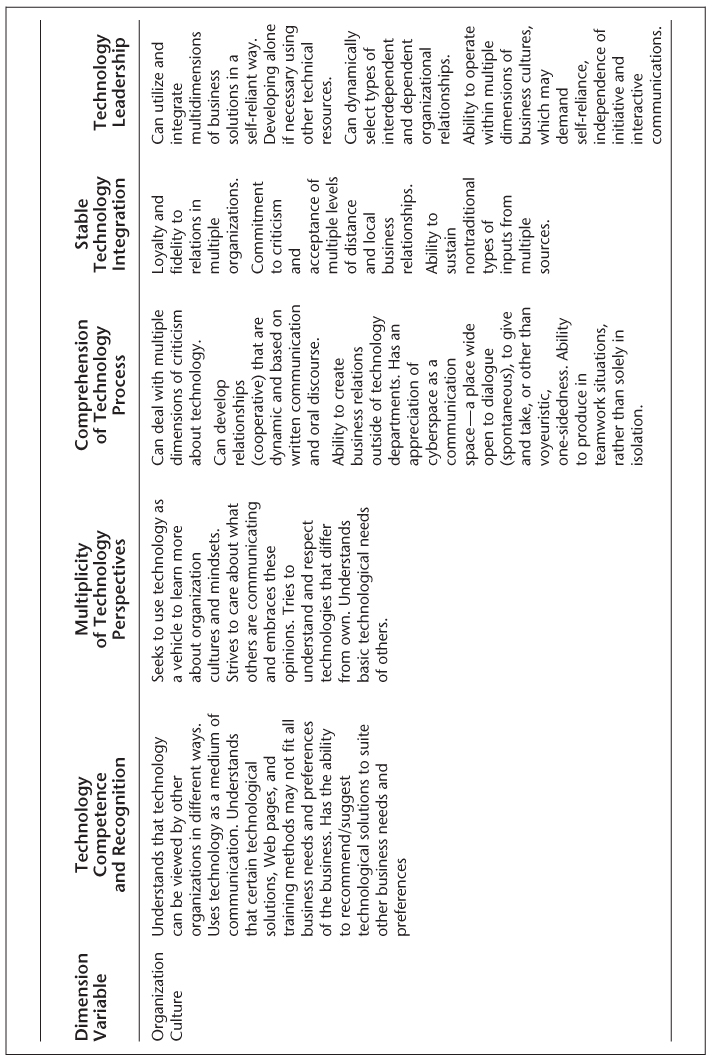
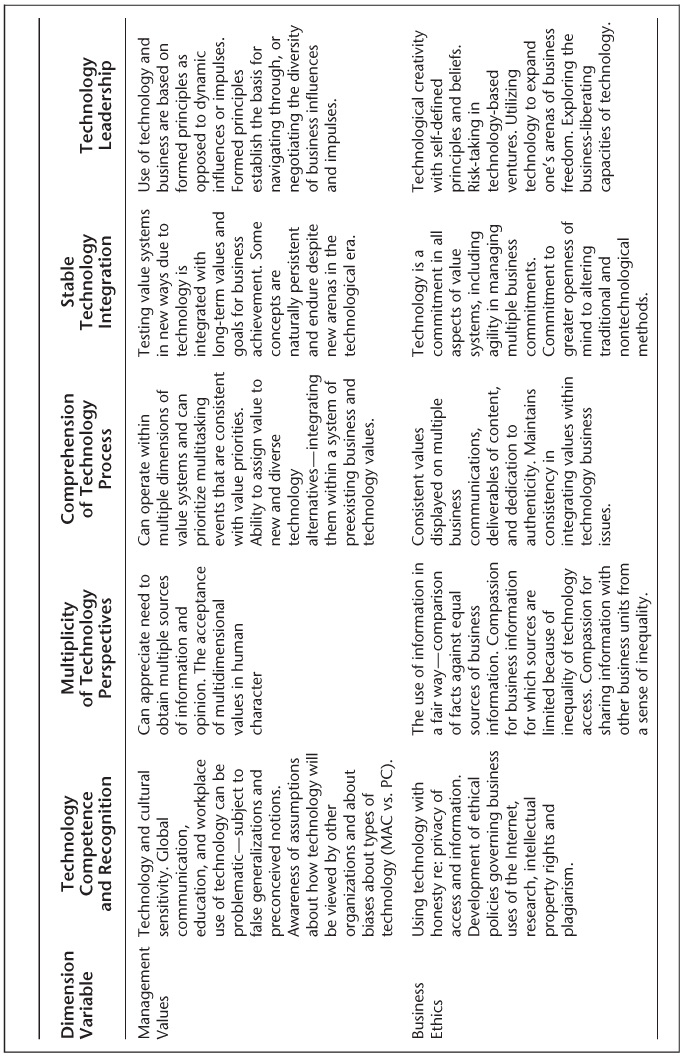

Chief Executive Officer
When attempting to define chief executive officer (CEO) best practices, one is challenged with the myriad of material that attempts to determine the broad, yet important role of the CEO. As with many best practices, they are typically based on trends and percentages of what most CEOs do—assuming of course that the companies they work for are successful. That is, if their organization is successful, then their practices must be as well. This type of associative thinking leads to what researchers often call “false generalizations.” Indeed, these types of inadequate methods lead to false judgments that foster business trends that are misinterpreted as best practices. Reputation is what would better define these trends, which usually after a period of time become ineffective and unpopular. We must also always remember the human element of success—certain individuals succeed based on natural instincts and talent, hard work and drive, and so on. These components of success should not be confused with theories that are scalable and replicable to practice; that is what best practices need to accomplish.
This section focuses on technology best practices of the CEO. These best practices will be based on my research, as well as other positions and facts that provide a defendable context of how and why they appear to be effective. However, as with the chief IT executive model, best practices cannot be attained without an arc that integrates mature organizational learning and developmental theories. Many of the CEO best practices are reconciled against previous interviews with CEOs. Other published definitions and support will be referenced in our presentation.
In February 2002, Hackett Benchworking, a part of Answerthink Corporation, issued its best practices for IT. Their documentation states: “In compiling its 2002 best practices trend data, Hackett evaluated the effectiveness (quality and value) and efficiency (cost and productivity) of the information technology function across five performance dimensions: strategic alignment with the business; ability to partner with internal and external customers; use of technology; organization; and processes.”6 Their findings as they apply to the CEO function provide the following generalizations:
- There was an 85 percent increase in the number of CIOs that reported directly to the CEO. This increase would suggest that CEOs need to directly manage the CIO function because of its importance to business strategy.
- CEOs that supported outsourcing did not receive the cost cutting effectiveness that they had hoped. In fact, most break even. This suggests that CEOs should not view outsourcing as a cost-cutting measure, but rather foster its use where there is identifiable business benefits.
- CEOs have found that IT organizations that have centralized operations save more money and have fewer help-line calls than decentralized organizations and without sacrificing service quality. This suggests the CEOs should consider less business-specific support structures especially when they have multiple locations of business.
- CEOs are increasingly depending on the CIO for advice on improving the business with technology. Their view is that IT professionals then should have advanced business degrees.
- CEOs should know that consistent use of IT standards has enabled firms to trim IT development costs by 41 percent, which has reduced costs for end-user support and training operations by 17 percent.
- CEOs need to increase support for risk management. Only 77 percent of average companies maintain disaster-recovery plans.
As we can see from these generalizations, they are essentially based on what CEOs are doing and what they have experienced. Unfortunately, this survey addresses little about what CEOs know and exactly what their role should be with respect to overall management, participations, and learning of technology. These “best practices” are particularly lacking in the area of organizational learning and the firm's abilities to respond to changing conditions as opposed to searching for general solutions.
Langer formulated a list of 11 key planks that represent the core of what constitutes a technology CEO's set of best practices:
The issue is now to provide a linear development model for CEOs that enables them to measure where they are in relation to ROD and the best practices outlined earlier.
The CEO Best Practices Technology Arc
Similar to the Chief IT Executive Arc, the CEO Best Practices Arc is an instrument for assessing the technology best practices of CEOs. The arc evaluates a CEO's strategic uses of technology and leadership by using a grid that charts competencies ranging from conceptual knowledge about technology to more complex uses of technology and business and how they are integrated in strategic business planning.
As with all arc models, the CEO version measures five principal stages of a CEO's maturity with respect to business applications of technology: conceptual, structural, executive values, executive ethics, and executive leadership. Each dimension or sector is measured in five stages of maturation that guides the CEO's executive growth managing technological dynamism. The first stage is in being reflectively aware about their conceptual knowledge with technology and what it can do for the organization. The second is “other-centeredness” where CEOs become aware of the multiplicity of business uses of technology and the different views that can exist inside and outside the organization. The third is “Integration of Business use of Technology,” where a CEO can begin to combine how business plans foster the need for technology. The fourth is “Implementation of Business/Technology Process,” meaning that the CEO understands how business applications and technology are used together and is resilient to nonauthentic sources of emerging technology. Stage four represents an ongoing implementation of both technology and business applications. The fifth is “Strategic Uses of Technology” in which CEOs have reached a stage where their judgment on using technology and business is independent and can be used to self-educate from within. Thus, as CEOs grow in knowledge of business uses of technology they can become increasingly more understanding of the multiplicity of uses, more integrated in how they conceptualize technology, can manage its implementation from an executive position, and can apply new strategies to support new applications of technology in the organization.
Definitions of Maturity Stages and Dimension Variables in the CEO Technology Best Practices Arc
Maturity Stages
Performance Dimensions
Figure 6.5 shows the CEO technology best practices arc in chart form.
Figure 6.5 Developmental Dimensions of Maturing

Each cell in the arc provides the condition for assessment. The complete arc is provided in Figure 6.6.
Figure 6.6 CEO Technology Best Practices Arc


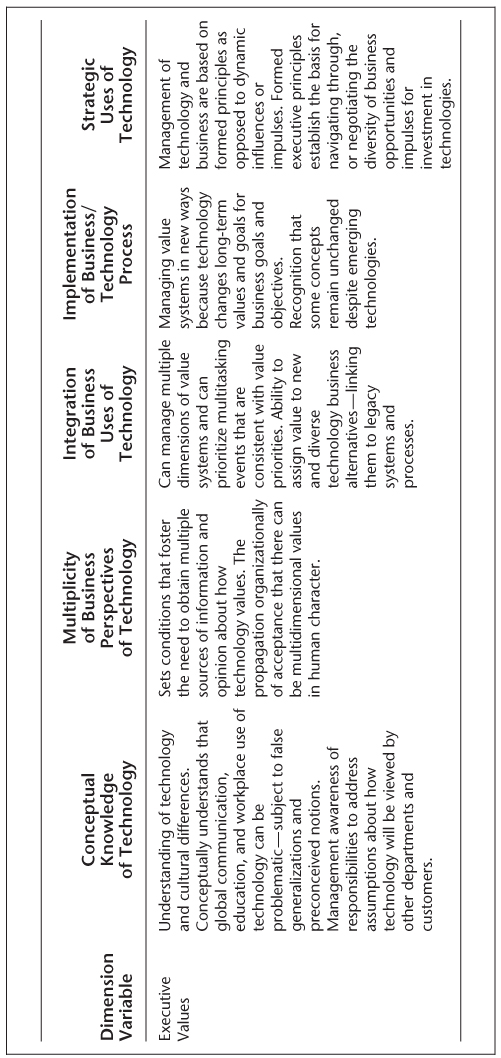

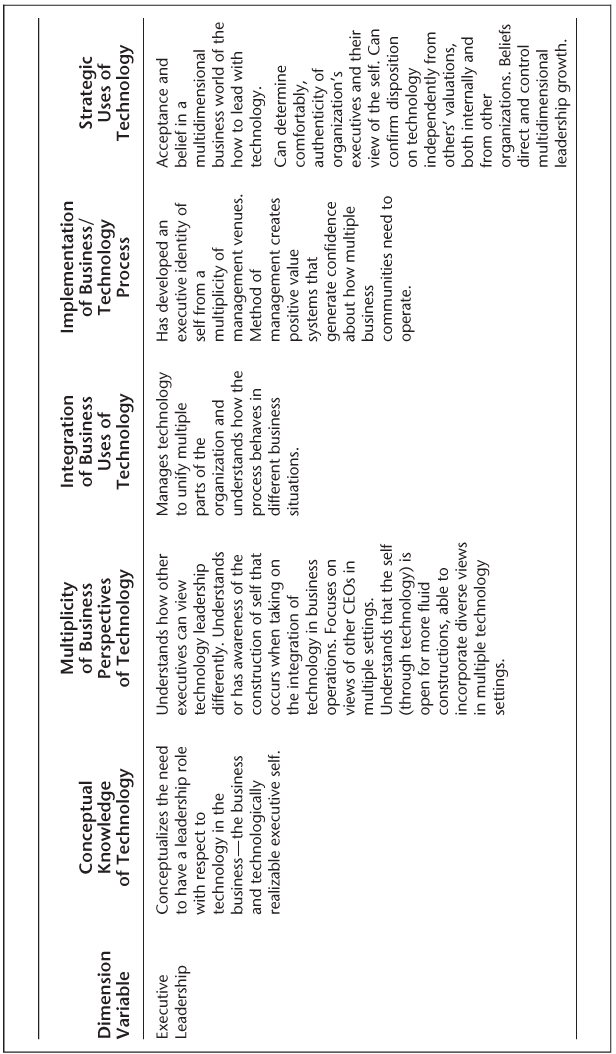
Middle Management
Middle managers can represent a number of management tiers, and is perhaps the most challenging of the best practices to define. Langer stratified the different types of positions that make up middle managers into three tiers: directors, line managers, and supervisors.8 The objective then is to create the set of technology best practices for managers so that they can effectively operate under ROD. It is also important for the CIO to attain these best practices to effectively establish the kind of organization that can integrate IT and non-IT personnel. That is, technology best practices must be designed to contain the eight insights and skills for effective management of technology.
As with CEO research, there is a myriad of best practices that have been offered as a method of dealing with the subject of “technology management.”
Unfortunately, these practices usually are vague and intermingle management levels and departments, that is, it is difficult to know whether the best practice is for the chief IT executive, the CEO, or some other level of management. We know from the research from Bolman and Deal that middle managers feel torn by conflicting signals and pressures they get from both senior management and the operations that report to them.10 “They need to understand the difference in taking risks and getting punished for mistakes.”11 According to a 2003 study performed by SRI Consulting Business Intelligence, best practices for middle managers need to cover the following eight areas:
The study covered more than 400 companies in the previous eight areas of concern (I extracted the following 10 middle-management-related best practices from the study results and concluded that middle managers need to):
Upon reviewing the different aspects of middle manager best practices with technology research, it appears that there are two focal points: (1) those best practices that address the needs of senior management, the CIO, and the CEO, and (2) those that are geared toward the management of the staffs that need to implement emerging technology projects. This makes sense, given that the middle manager, notwithstanding whether they are a director, line manager, or supervisor, needs to deal with executive productivity related issues and implementation staff related ones. They are, as Bolman and Deal stated, “torn” by these two competing organizational requirements. Table 6.1 represents the combined list of technology-based best practices organized by executive-level best practices and implementation best practices.
Table 6.1 Executive-Based Middle Manager Best Practices

The matrix in Table 6.1 exemplifies the challenge that middle managers have in order to balance their priorities. In accordance with the research, the previous best practices are implemented using methods of knowledge management, alignment, leadership and commitment, human resources, opportunity management, leveraging, and performance assessment. As with the other best practices, the middle manager technology best practices are limited because they do not address the specific needs of ROD, particularly organizational learning theories (with the exception of knowledge management). This shortfall is integrated into another developmental arc model that combines these theories with the best practices defined earlier.
The Middle-Management Best Practices Technology Arc
This arc can be used to evaluate a middle manager's strategic and operational uses of technology by using a grid that measures competencies ranging from conceptual knowledge about technology to more complex uses of technology and business operations.
The five principal stages defined by the arc determine the middle manager's maturity with business implementations of technology: cognitive, organization interactions, management values, project ethics, and management presence. There are five stages of maturation that guide the middle manager's growth. The first is becoming reflectively aware about one's existing knowledge with business technology and how it can be implemented. The second is the recognition of the multiple ways that technology can be implemented on projects (e.g., other business views of how technology can benefit the organization). The third is the integration of business implementation of technology in which a middle manager can begin to combine technology issues with business concepts and functions on a project basis. “The fourth is the stability of business/Technology implementation” in which the middle manager has integrated business and technology as a regular part of project implementations. The fifth is technology project leadership in which the middle manager can use his or her independent judgment on how best to use technology and business on a project-by-project basis. Thus, as middle managers grow in knowledge of technology and business projects, they can become increasingly more open to new methods of implementation and eventually autonomous with the way they implement projects and provide leadership.
Definitions of Maturity Stages and Dimension Variables in the Middle-Management Best Practices Arc
Maturity Stages
Performance Dimensions
Figure 6.7 shows the middle-management technology best practices arc in chart form.
Figure 6.7 Middle-Management Technology Best Practices Arc

Each cell in the arc provides the condition for assessment. The complete arc is provided in Figure 6.8.
Figure 6.8 Middle-Management Technology Best Practices Arc

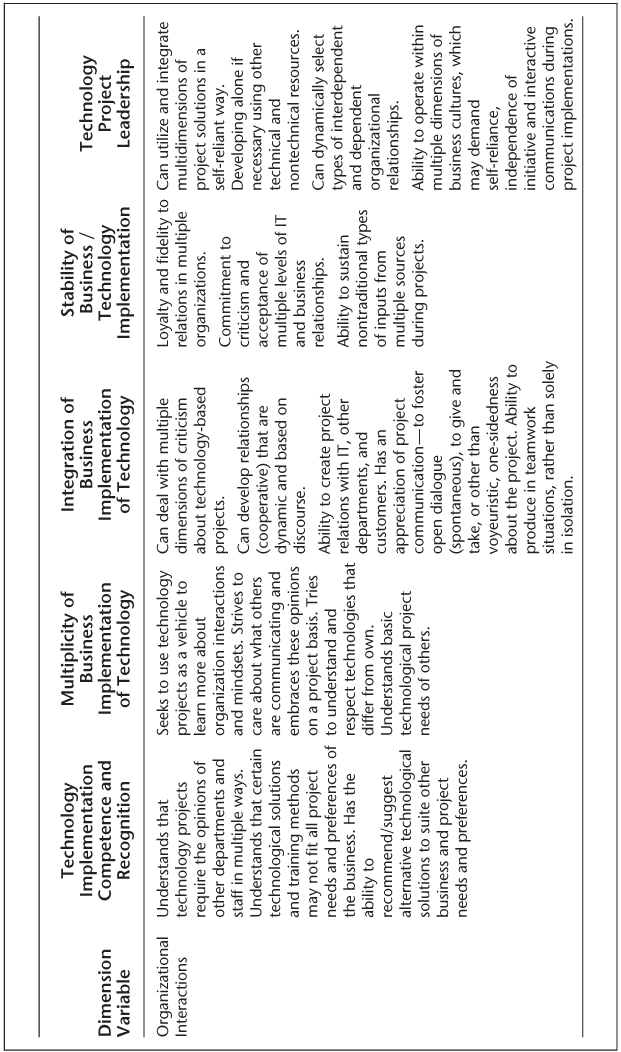


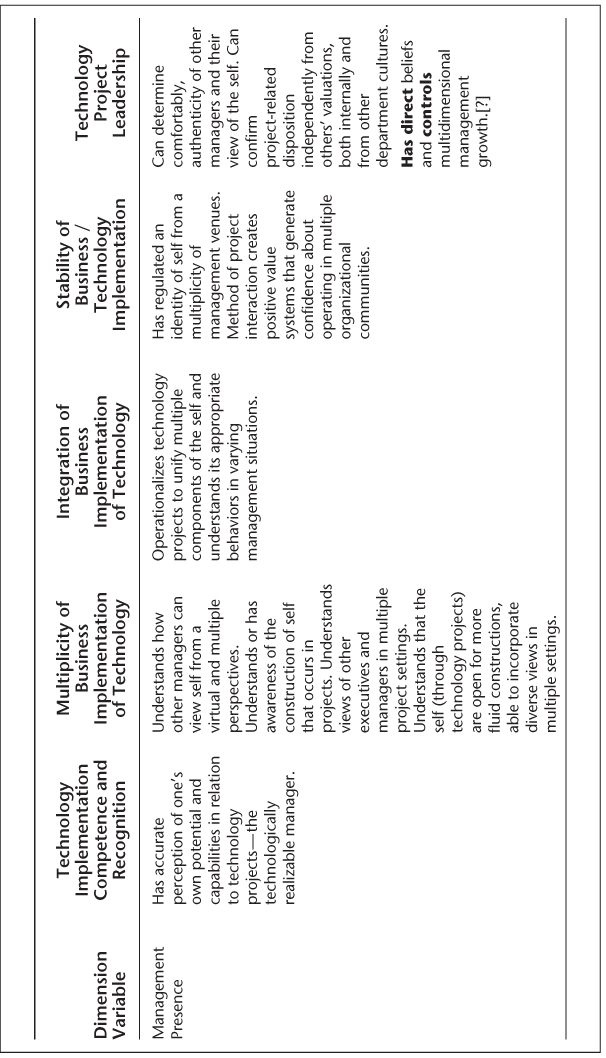
The challenge of the middle-management best practices arc is whether to emphasize executive management concepts (more organizationally intended) or event-driven concepts (project oriented). This arc focuses on project implementation factors and deals with best practices that can balance executive pressures with implementation realities. I suggest that senior middle managers, at the director level, who do not participate in implementation, set their own best practices on the model of the CEO maturity arc and best practices. In any event, yet another maturity arc appears to have too many overlapping cells.
Conclusion
The formation of best practices to implement and sustain ROD is a complex task for any CIO. It involves combining traditional best-practice methods (that is, what seems to work for proven organizations) with developmental theory on individual maturation. The combination of these two components provides the missing organizational learning piece that supports the attainment of ROD. Another way of comprehending this concept is to view the Responsive Organizational Dynamism Arc as the overarching or top-level model.
The other maturity arcs and best practices represent the major communities of practice that are the subsets of that model. This is graphically depicted in Figure 6.9.
Figure 6.9 Organizational Dynamism: Best Practices and Maturity

Thus, the challenge is to create and sustain each community and at the same time establish synergies that allow them to operate together. This is the organizational climate required, where the executive board, senior and middle managers, and operations personnel must form their own subcommunities, while at the same time had the ability for both downward and upward communication. In summary, this particular model relies on the CIO to drive the key management interfaces that are needed to support rod.
Notes
1 A. M. Langer, Information Technology and Organizational Learning: Managing Behavioral Change through Technology and Education, 2nd ed. (Boca Raton, FL: Taylor and Francis, 2011).
2 Ibid.
3 Ibid., p. 111.
4 Ibid.
5 Ibid.
6 Hackett Benchmarking has tracked the performance of nearly 2000 complex, global organizations and identified key differentiators between world-class and average companies across a diverse set of industries. In addition to information technology, staff functions studied include finance, human resources, procurement, and strategic decision making, among others. Study participants comprise 80 percent of the Dow Jones Industrials, two thirds of the Fortune 100 and 60 percent of the Dow Jones Global Titans Index. Among the information technology study participants are Agilent Technologies, Alcoa, Capital One Financial Corporation, Honeywell International, Metropolitan Life Insurance, SAP America, and TRW (Source: PR Newswire, February 2002).
7 Langer, Information Technology and Organizational Learning.
8 Ibid.
9 Ibid.
10 L. G. Bolman and T. E. Deal, Reframing Organizations: Artistry, Choice, and Leadership, 2nd ed. (San Francisco: Jossey-Bass, 1997).
11 Ibid., p. 27.
